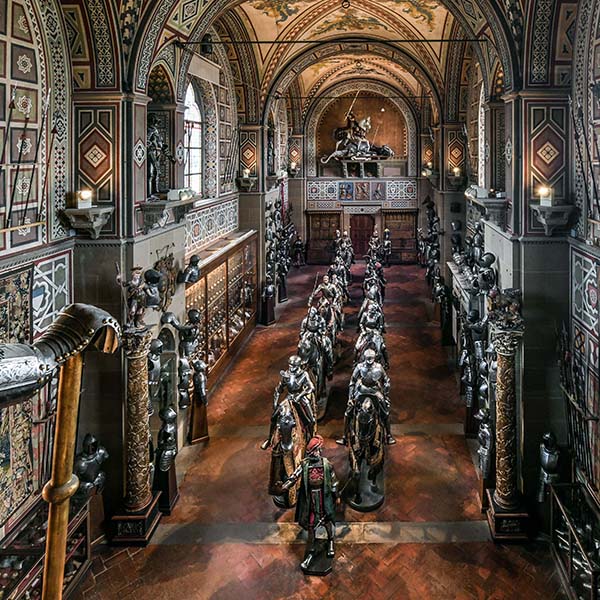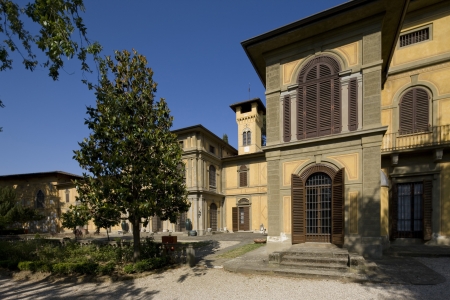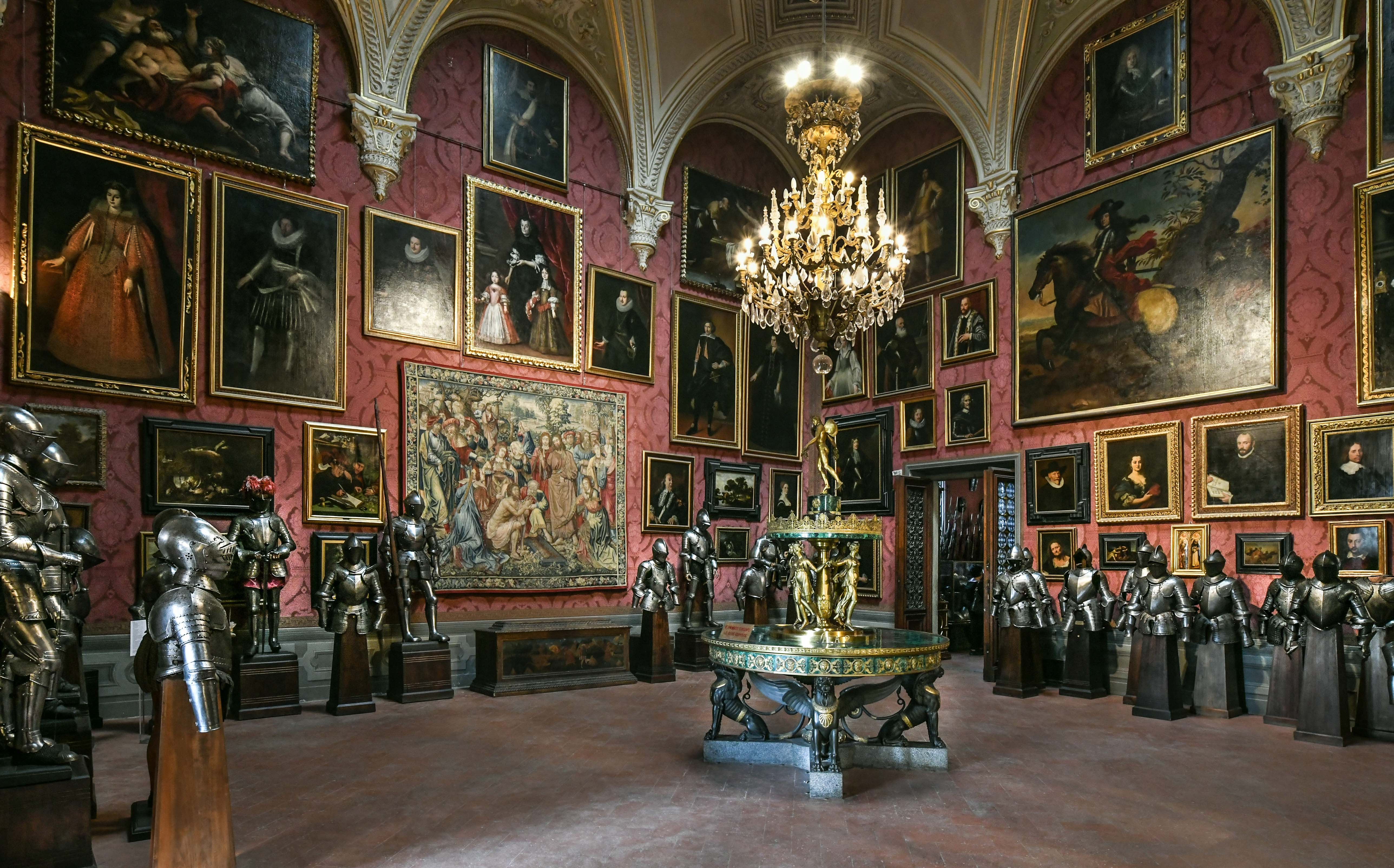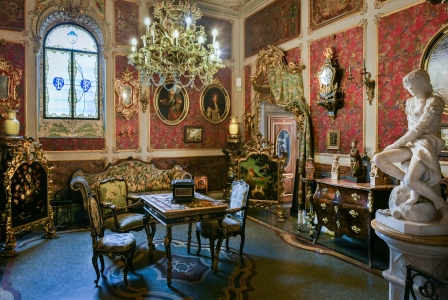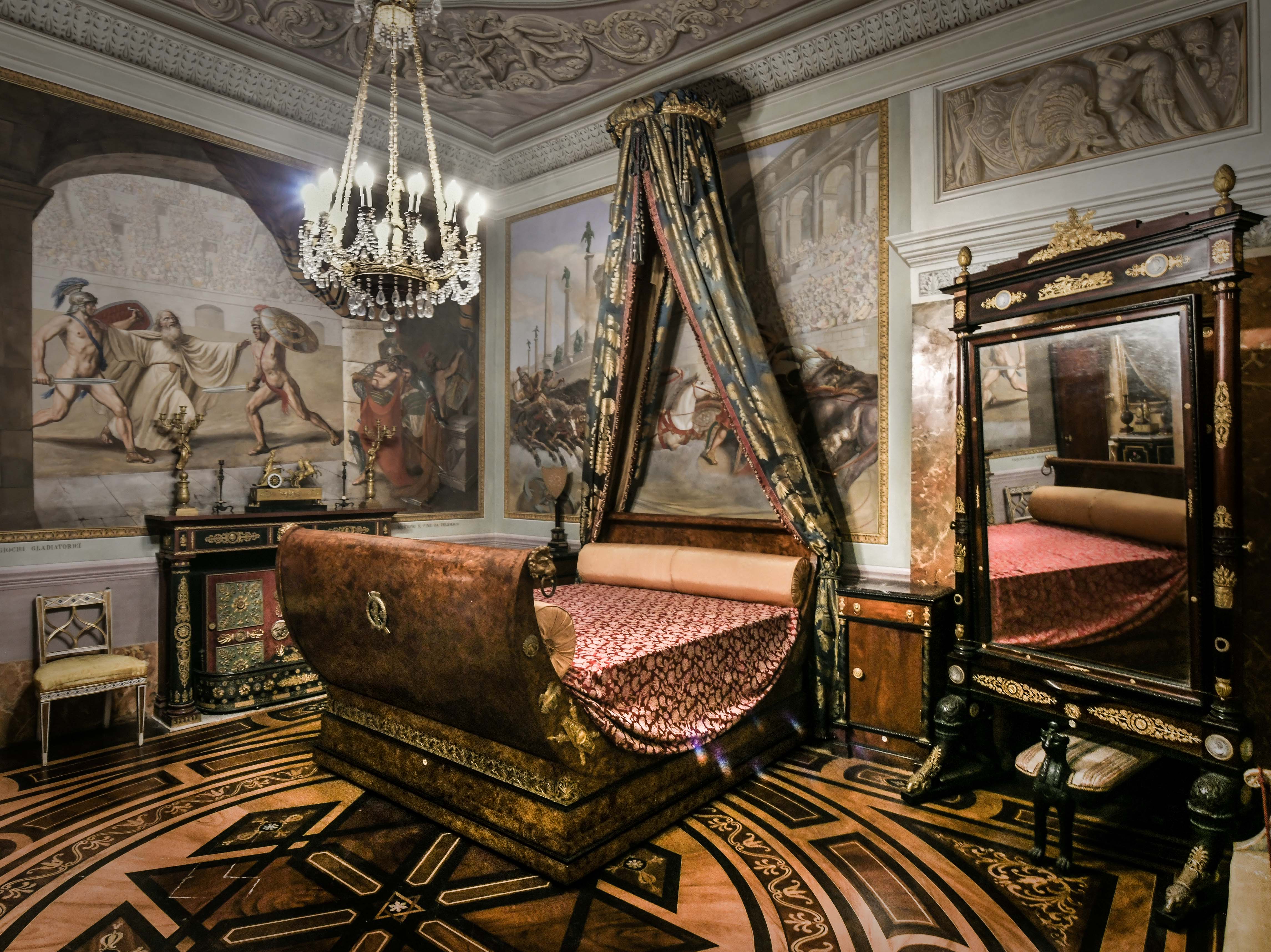Interview to Enrico Colle
Director Museo Stibbert in Florence
Who was Frederick Stibbert?
Frederick Stibbert was born in Florence in 1838, from an English father – Thomas Stibbert, colonel of the prestigious Coldstream Guards, who had moved to Italy after the anti-Napoleonic campaigns – and an Italian mother, Giulia Cafaggi. As a British citizen, he was educated in England, at Harrow College in Cambridge, albeit in a somewhat turbulent manner due to his restlessness. After his father’s death in 1847 – Stibbert was still a child – his mother had bought the villa at Montughi, where she moved two years later from the city palace, keeping her children in a very high social standing in Florence, thanks to the friendship of the Fenzi, bankers to whom his father had turned to administer his estate: a financial fortune that Stibbert would inherit when he came of age, as the last male descendant of the family line. The Stibbert’s riches had begun in India with his grandfather, governor of Bengal and commanding general of the East India Company: in the 1870s, Frederick Stibbert’s financial fortune was calculated at 13 billion lire, making him the fifth richest citizen of Florence. After finishing his studies at Cambridge he had returned to Italy in 1860, in his early twenties, immediately embracing the Italian cause of unification, so much so that together with some friends he enlisted in Garibaldi’s army, and then fought in the Trentino Campaign of 1866, which earned him the silver medal for valour. It was in the 1860s, when Florence emerged from the Grand Duchy into the wider context of a united Italy, that Stibbert began his collecting activity and the transformation of the villa at Montughi into a museum.
What was his background?
Stibbert’s education was that of a nineteenth-century Englishman. During his college years at Cambridge he had come into contact with many different characters and studied many collections. He had certainly visited the Tower of London several times, where all the English Royal Armoury was on display, and was fascinated by what was called the Line of Kings, created in the 17th century for Charles II, where historical armours were displayed on wooden figures in a parade of horses. And then, the neo-Gothic taste that was very much present in England, starting with the Strowberry Hill mansion that Horace Walpole had built on the banks of the Thames, considered by historians as the beginning of the Gothic Revival. Walpole had thought of the mansion almost as a museum, and had furnished it with various works and objects, among them the collection of arms and armour, the first made by a private individual at the end of the 18th century. Finally, the passion for painting, which Stibbert had studied as a child with tutors his mother wanted, so that they could teach him technique and history. These years of English education – which can be considered as a first smattering for later studies – and the economic means that he certainly did not lack, made him decide to begin his Italian life upon his return to Florence with the creation of a museum, which from that moment on would become the focus of all his efforts and interests. However, in spite of many other English collectors who had preceded him or were his contemporaries, who considered Florence as a second home, and bought mainly Renaissance paintings, Stibbert decided to do something no one had ever thought of before: to build an armoury.
Starting from his English formative years, the neo-Gothic and chivalrous taste, how did his interest in the history of military costume come about?
The historic armoury of the Medici was dispersed by the Lorena family at the end of the 18th century. The Medici had collected all kinds of objects, and their legacy had formed the Uffizi, the Florentine Pitti Palace, the Bargello, the science and ethnographic museums, and others. Thus, all the sections that constituted that varied collecting world of the Medici were represented in some Florentine institution. What was lacking, however, was a museum of armoury, a gap that Stibbert in a certain way decided to fill by creating a collection not only inspired by the Middle Ages or the Renaissance – as other people abroad were also doing – but, with a much broader vision, an armoury encompassing all ages and all nations, thus embracing Europe, the Middle Ages, all the way to the Far East with Japanese armoury, giving a global vision of the evolution of war costumes. Yet Stibbert goes further, and the next step is to broaden his interests to include the history of costume, including civilian costume, of which the museum has an exhaustive collection (less well known because it is kept in storage as it cannot be exhibited continuously), which ranges in the same way as military costumes across countries and continents.
How did the collection develop over the years in relation to his interests?
The initial element was studying, which revolved around his interests, and starting with armoury, which in the beginning was the dominant sector, and then costumes, painting and the other arts, the various types of objects he acquired were all based on history, so that he could understand and date what he was gradually collecting. A collector’s and scholar’s approach that included a large library, focused on the history of costumes and armour, with books both manuscripts and printed texts, which, once the restoration work was completed, will be opened to the public. Everything he could acquire in view of his museum he had made: we have a large picture gallery with paintings from the 15th to the 18th century, mainly portraits, which we are in the process of re-evaluating; around 2,750 prints dating from the 16th to the 19th century, and several series of porcelain objects. An approximate inventory made post mortem mentioned 50,000 objects – but in reality there are many more due to donations and later purchases – collected over fifty years of collecting, from 1860 until his death in 1906. I think I can describe Stibbert’s collection as a treasure within a treasure.
How was the armour collection structured?
Stibbert collected by creating type sections. Of every single piece of armour he would acquire several specimens. There are, for example, dozens and dozens of armour busts, but also smaller items such as sword knobs, which gave him a total view of the evolution of taste and style, but also because many suits of armour were in need of restoration and the pieces were used to reconstruct them. Like a true collector of every object he would create a series and acquire a type. He also bought for entire lots, such as the nucleus of Islamic armour from a precious Livorno collection established in the 18th century, which his heirs were disposing of, with masterpieces from the Armoury of Saint Irene in Istanbul.
What are the most representative objects in the museum?
In the field of European Armoury there is certainly the Borromeo Armour, datable between 1585 and around 1590, signed by Pompeo della Cesa, one of the most skilled Milanese armourers of the second half of the 15th century, who signed other pieces in the collection. It is a complete suit of armour, apart from the helmet conserved at the Poldi Pezzoli Museum in Milan, which in a certain way ties us together. In the Islamic section there are very important ancient sabres and daggers, which testify to the history of these objects passed from one sultan to another, and then enriched with precious stones; while the oldest pieces from the Armoury of St. Irene date from 1480-1500, recognisable by a punch, the so-called tamga, which bore a stylised bovine head identifying the arms of the armoury. The Japanese collection is studded with many suits of armour from the 19th century, but also with older objects, such as certain very rare helmets. In the museum house, the fireplace in the ballroom, carved in wood to monumental dimensions, represents Stibbert’s last financial folly. He called in Egisto Gaiani for this undertaking, a Florentine sculptor and carver much sought after in Italy and Europe, who worked for the great English and American houses. Stibbert’s collection of costumes is particularly important for its focus on men’s clothing, of which there are very important specimens dating back to the late 17th century. Also of interest is the collection of waistcoats, in a wide variety of patterns and decorations, as well as accessories and even women’s clothing, consistent with its focus on the history of costume. The engravings and prints constitute a very heterogeneous collection and have recently been catalogued and digitised. There are about 2,750 of them and they range from the 16th to the 19th century. Ceramics and porcelain are part of the objects that Stibbert bought mainly for decoration, but in particular the porcelain was later enriched by a collection coming from Baron de Tschudy, and deposited after Stibbert’s death at the Museum in 1914. The most spectacular pieces are three large sculptural groups in Ginori porcelain from the 1750s, which Stibbert would certainly have enjoyed owning, and thus fit in well with his collection. Also interesting is the nucleus of majolica produced by Cantagalli, the most spectacular of which is the majolica Loggia that opens near the great Ballroom. Frederick Stibbert and Ulysses Cantagalli were friends, and many works of this production were used in the decoration of the walls of the house, later removed with the opening of the Museum and difficult to relocate today, as is also part of the tapestry collection.
How did Frederick Stibbert design and set up his museum?
What fascinates and somehow separates, and makes Stibbert a case apart from the collectors of the late 19th and early 20th century, is that he tries to give his collection a display criterion. Of course, it would have been very boring to display objects next to each other according to a typical 20th century taste – in vogue until the 1930s – that privileged the individual over the whole. Stibbert looks to historical armouries, such as the Royal Armoury in Turin, and takes from them the scenographic way of displaying objects. Skilled in painting, he personally designed his collection – the wall decorations, the overall scenography – with the support of the architects for the design and the masters of the house. We have many notebooks of his travels where he took note – more through drawing than writing – of what he saw, what he could acquire to expand his collection, but above all of the rooms as models for his museum. The villa in Montughi purchased by his mother was in fact becoming too small to house a collection that was already becoming conspicuous by the end of the 1870s. Stibbert – as had been his intention for some time – then decided to enlarge the villa and designed new rooms reserved for the Armoury, separate from what is now the museum house. His models were the cavalcades of the royal collections, not only English but also Spanish and French, giving the decorators precise indications through numerous drawings that have survived: for the European Cavalcade he was looking for a neo-Gothic setting; for the Islamic one a scenography recalling Middle Eastern ornaments; and for the Japanese one a sort of mixture of English neo-Gothic and Far Eastern temple decorations, to underline the closeness between these two cultures so distant but with the same ideal: that of chivalry. Stibbert looks to the England of William Morris in the late 19th century, to that Anglo-Japanese taste typical of that time. The other decidedly avant-garde aspect of the museum’s layout is this sort of union between arts and cultures: we will never find in the rooms an aseptic display of armour, of masterpieces, but a setting where furniture and painting coexist harmoniously.
How important was the trip as a collecting opportunity?
Stibbert lived between Florence and England. He had a house in London, and like every elite Englishman he was a member of a club. He left in the spring with the start of the season which coincided with the opening of social events, when great receptions were held and the nobility of the castles poured into the city. He frequented aristocratic circles: he was friends with people very close to the court that he hosted at Montughi, such as the Dukes of Teck; he knew the heirs to the crown, so much so that he received Queen Victoria, who was staying in Florence at Villa Fabbricotti, bordering his property; but also men of culture such as Oscar Wilde. His departures to London were also an opportunity to stay in other countries, especially Northern Europe, but also in Eastern cities such as St Petersburg, or in the South in Spain. His itineraries were meticulously constructed and followed the collecting interests of the moment. Germany, for example, was a favoured destination for its important armour collections. His favoured markets were Paris and London, abroad, and Milan and Venice, as well as Florence and even Turin, in Italy.
What was Stibbert’s world like in Florence?
In Florence, he frequented the aristocracy (his sister Sophronia had married Count Alessio Pandolfini, while Erminia had died prematurely at the age of 16); he frequented the Circolo dell’Unione, the horse races of which he was passionate, the places where the Florentine and European elite met. He loved hunting and had a stable in the park of the villa, all those passions typical of Englishmen of his social class. He combined the mundane with the cultural, sponsoring causes related to the city of Florence, such as the reconstruction of the façade of the Duomo. Even in his youth he had contributed to the official opening of the Bargello Museum, lending some works for the inaugural exhibition in 1865. Being a very wealthy man, he happened to be involved in philanthropic works.
What kind of collector was Frederick Stibbert?
A typical collector, who had to collect the entire set: of a suit of armour all the pieces, of a suit all the accessories, of a servant the entire set; but also a scholar, who wanted to know and delve deeper. More than the idea of possession, it was the intellectual aspect of collecting that interested him, i.e. to give rise to studies on subjects little investigated until then, such as the decorative arts; because, while there were already advanced studies on painting and sculpture, very little was known about this segment of art: the idea of a museum on the history of costume, for example, only arrived in the second half of the 20th century. In this sense, I see Stibbert as a forerunner of the study of the decorative arts.
What are the premises of Giuseppe Poggi’s English-style romantic park?
The park with its small temples, grottoes and water features reflects the eclectic taste of the second half of the 19th century, such as the decor of the house with its draperies, the furniture of different styles united in a single room, the way oriental objects and European culture were displayed together. Initially it was a kind of Italian garden reflecting the late 18th century taste of the villa, which was turned upside down when Stibbert decided to enlarge it to build the wing destined for the museum in neo-Gothic style. What he was looking for was to find a harmony between the villa and the park, to create an outdoor setting that would act as a prologue to the museum, and the instructions given to Giuseppe Poggi were along these lines. He built the Venetian loggia, the Hellenistic temple and the Egyptian temple overlooking the lake, the grottoes, the lemon house. Environments that he decorates like the house: he buys the historical coats of arms from the destruction of the city centre that he places on the façade of the museum that houses the Cavalcade; he has furniture made in the Neo-Egyptian style by a famous Turin company, Parvis – the same company that worked for the chedivè – and decorates the small temple with sarcophagi and canopic jars purchased in Egypt, one of the first destinations that fascinated him as a traveller; for the Venetian loggia, inside and along the boundary walls, he placed stone fragments from the 15th and 16th centuries, originally from a Venetian Gothic palace, purchased in the lagoon city from the same merchant as Isabella Stewart Garden. All this was designed so that the visitor being introduced to the collections and the richness of the interior would experience a kind of initiatory journey.
Making a museological assessment today, what are the peculiarities of the Stibbert Museum?
The unique aspect of this Museum is also that it has kept intact the layout Stibbert made in the second half of the 19th century. There are museums, always born out of private collecting, such as the Poldi Pezzoli in Milan – an example from which Stibbert may have been inspired in some way – that were bombed during the war, suffered devastation and tampering; while this villa, which stood on a hill just outside Florence, was spared any havoc; but also by the testamentary will of Stibbert himself, who at his death in 1906 bequeathed the collections and the villa to the City of Florence, so that it would be open to the public and scholars. Stibbert set up the Museum not only to document the history of costume, armour and chivalric life, but also to create an exhibition consistent with his tastes. The style of the museum house is that of the great mansions of the 19th century, of the great collections where there was room for antique furniture, for furniture of the 17th and 18th centuries; even – to link me back to the study of decorative arts and museographic expedients – Stibbert thinks of what in the 1950s would become the period rooms of English and French foreign museums, and recreates two rooms as examples of taste: a French rococo room and a Renaissance studiolo. The Armoury is also unique, with a taste that cannot be compared to that of any other museum contemporary with him. Stibbert moves on the double track of the collector but also of the museographer and the scholar, who begins a great journey of analysis of the decorative arts.
Who are the visitors to the Stibbert Museum?
The Stibbert is very popular with young people because it is fascinating, stimulating and at the same time a viaticum for museums like the Uffizi, Palazzo Pitti, or the Bargello in Florence. We welcome many school groups, but also many families: it is even a tradition to bring one’s children to the Stibbert, an initiation visit. It is also much sought after by foreigners, to whom it is related more than to Italians in terms of museum type and type of collections.

